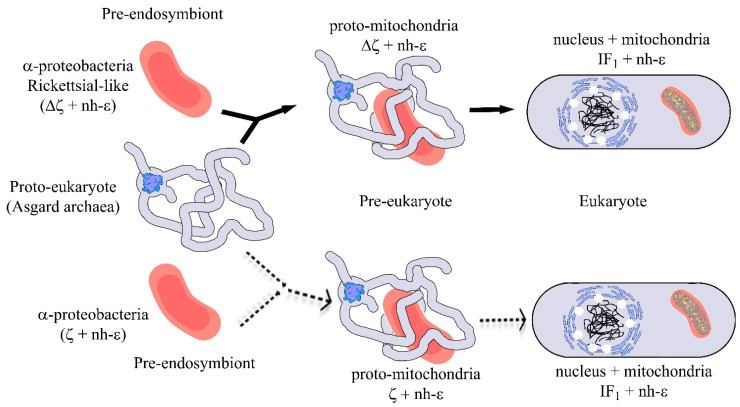Figure 6.
Simplified mitochondrial endosymbiotic events with an α-proteobacterial pre-endosymbiont having or lacking the ζ gene. The upper part (black arrows) shows the most likely mitochondrial endosymbiotic event, assuming that ζ is not a homolog of IF1, with a Rickettsial-like pre-endosymbiont lacking the αPATPsζ gene (Δζ), which evolves within a pre-eukaryote from being an intracellular parasite into a proto-mitochondria lacking ζ and already having a non-inhibitory ε subunit (nh-ε) in its F-ATP synthase. This eventually transforms into mitochondria in an enucleated eukaryote. In this more likely scenario, ζ and IF1 arose separately by convergent evolution. In mitochondria, IF1 evolved not only to preferably inhibit the F1FO-ATPase activity, but also to stabilize the mitochondrial F-ATP synthase dimers, and further oligomers that give its shape to the cristae of the mitochondrial inner membrane (see yellow spots of F-ATP synthases in the curved portions of cristae and Figure 7). The lower part (dashed light arrows) shows a less likely alternative scenario where ζ is the predecessor of IF1 and where an α-proteobacterial pre-endosymbiont having ζ and containing an nh-ε became a protomitochondria in the pre-eukaryote, and this evolved to become IF1 in mitochondria of the nucleated eukaryote. This alternative is less likely because of the low identity between ζ and IF1 and because there is no evidence of the presence of IF1 genes in α-proteobacteria or other bacteria, and the other way around, there is no trace of ζ genes in eukaryotes. See text for further details. Figure adapted from Ref. [96].

